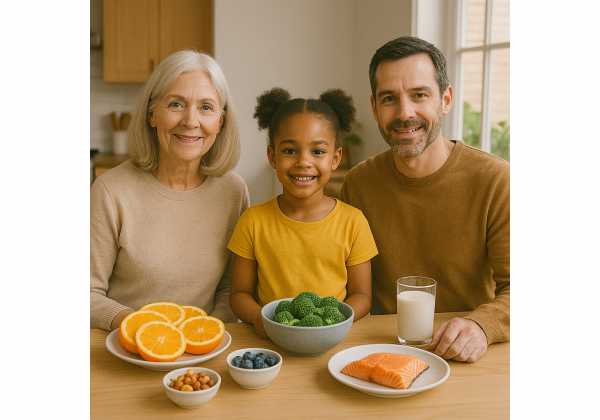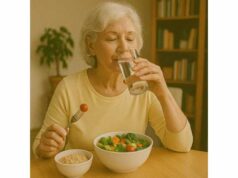
A resilient immune system becomes more important with every decade. While no single nutrient can prevent illness, a steady pattern of vitamin C, vitamin D, and zinc from food helps maintain the immune cells that keep you healing well, responding to vaccines, and recovering faster. This guide translates the science into everyday plate choices—what to eat, how much, and how to combine foods so your body actually uses what you consume. You will also find seasonal strategies for winter sunlight gaps, practical pantry swaps, signs of deficiency, and safety limits. If you want a broader framework for building a longevity-friendly plate, explore our companion piece on balanced longevity nutrition patterns before or after you read this article.
Table of Contents
- Immune Basics: Why C, D, and Zinc Matter with Aging
- Top Food Sources and Portions to Hit Daily Targets
- Absorption and Pairing: Fat with D, Citrus with Iron, and More
- Seasonal Strategies: Winter Sunlight Gaps and Pantry Staples
- Deficiency Signs, Testing Options, and Safety Limits
- Seven Immune-Friendly Meal and Snack Ideas
- When to Seek Professional Guidance
Immune Basics: Why C, D, and Zinc Matter with Aging
Aging changes the immune system gradually. The thymus shrinks, naïve T cells decline, and chronic, low-grade inflammation rises. That combination—fewer new defenders and a more “activated” baseline—can mean slower healing, weaker vaccine responses, and higher risk from everyday infections. Nutrition does not reverse these processes, but it can support the parts that remain adaptable: barrier integrity (skin, gut, airways), antioxidant defenses, and the precise signaling that tells immune cells when to act and when to stand down.
Vitamin C is water-soluble and active in the fluid spaces that bathe our cells. It supports neutrophil and macrophage function (the first responders), helps immune cells generate reactive oxygen species safely, and then helps quench the leftover oxidative byproducts. Because C is not stored in large amounts, daily intake matters. Stressors—illness, smoking, wound healing—can increase needs, so maintaining steady dietary sources is practical insurance.
Vitamin D acts more like a hormone than a typical vitamin. Many immune cells carry vitamin D receptors, and some can activate circulating 25-hydroxyvitamin D into its active form. Adequate vitamin D helps regulate the balance between pro- and anti-inflammatory signals and may improve defense at epithelial surfaces (skin, gut, lungs). Unlike vitamin C, vitamin D can be made in the skin with UVB exposure and stored in body fat, but synthesis is highly seasonal and declines with age due to thinner skin and more indoor time.
Zinc is a structural and catalytic mineral for hundreds of enzymes. From DNA transcription to antioxidant enzymes and wound repair, zinc is deeply embedded in immune development and day-to-day function. Even marginal shortfalls can impair taste and appetite, reduce skin and mucosal protection, and blunt lymphocyte activity. Because zinc is not heavily stored, consistent intake—especially from absorbable sources—is important.
Think of these three as complementary. Vitamin C supports frontline function and antioxidant control; vitamin D coordinates the overall inflammatory tone and immune readiness; zinc helps build, repair, and regulate the cellular machinery. A longevity-minded plate prioritizes reliable daily intakes from diverse foods so that short falls in one area do not compound into wider immune vulnerability. Below, you will find concrete, food-first ways to meet targets and pair foods for better absorption.
Top Food Sources and Portions to Hit Daily Targets
Before choosing foods, note practical daily baselines for adults: vitamin C ~75 mg for women and ~90 mg for men (smokers need +35 mg), vitamin D 15 mcg (600 IU) to age 70 and 20 mcg (800 IU) at 71+, and zinc 8 mg for women and 11 mg for men. You can meet these with ordinary meals if you know where to look and how much counts.
Vitamin C-rich foods (typical portion and approximate vitamin C):
- Red bell pepper, ½ cup raw: ~95 mg. A small salad or fajita topping easily covers most of the day’s need.
- Kiwi, 1 medium: ~60–70 mg. Two kiwis satisfy most daily needs.
- Orange, 1 medium: ~65–70 mg. A whole fruit beats juice for fiber and satiety.
- Strawberries, 1 cup halves: ~85–90 mg. Seasonal bowls or a yogurt topping work well.
- Broccoli, ½ cup cooked: ~50 mg. Add to stir-fries or pasta for a reliable boost.
- Brussels sprouts, ½ cup cooked: ~45–50 mg. Roast a tray and reheat through the week.
Vitamin D sources (food contributions vary widely; approximate vitamin D given in micrograms [mcg] and IU):
- Trout or salmon, 3 oz cooked: ~9–16 mcg (360–650 IU), depending on species and farming vs wild. Two fish dinners weekly smooth out day-to-day variation.
- Fortified milk or plant milk, 1 cup: ~2.5–3.5 mcg (100–140 IU). Check the carton—fortification can differ by brand.
- Fortified yogurt, 6 oz: ~2–3 mcg (80–120 IU). Choose versions that list vitamin D on the Nutrition Facts panel.
- Egg, 1 large: ~1 mcg (40–50 IU), concentrated in the yolk.
- UV-exposed mushrooms, ½–1 cup cooked: widely variable, often ~5–10+ mcg (200–400+ IU). Labels that mention “UV-treated” are your best guide.
- Fortified breakfast cereals, 1 serving: typically ~2–3 mcg (80–120 IU). Pair with milk to stack the dose.
Zinc sources (portion and approximate zinc):
- Oysters, 3 oz cooked: 25–45 mg. A once-a-month meal can replenish body pools quickly.
- Beef (chuck, round), 3 oz cooked: ~5–7 mg. Rotate with poultry and legumes to balance saturated fat.
- Pork, 3 oz cooked: ~2–3 mg. Choose lean cuts and trim visible fat.
- Chicken thigh, 3 oz cooked: ~2–3 mg. Dark meat carries slightly more zinc than breast.
- Pumpkin seeds, 1 oz (¼ cup): ~2–3 mg. Sprinkle over salads or yogurt.
- Chickpeas, ½ cup cooked: ~1–1.5 mg. Hummus with whole-grain crackers makes a practical snack.
- Lentils or black beans, ½ cup cooked: ~1–1.3 mg. Combine with vitamin C-rich salsa to improve absorption.
- Dairy (yogurt, 1 cup): ~1–2 mg. Helpful when combined with other zinc foods during the day.
Putting it together in portions that hit targets:
- Breakfast: Fortified yogurt (~2–3 mcg D) with strawberries (~85 mg C) and pumpkin seeds (~2–3 mg Zn).
- Lunch: Lentil bowl (~1 mg Zn) with roasted red peppers (~95 mg C) and olive oil; add a boiled egg (~1 mcg D).
- Dinner: Trout (~12 mcg D) with broccoli (~50 mg C) and quinoa; total zinc for the day rounded out with beef or a seed snack if needed.
Plant-based eaters can meet zinc needs by leaning on legumes, seeds, and whole grains while using preparation techniques (soaking, sprouting, sourdough) that reduce phytates and improve absorption—details in the next section. For a broader pattern that fits these foods into an all-day template, see our guidance on protein-plus-produce meal structure.
Absorption and Pairing: Fat with D, Citrus with Iron, and More
Nutrients only help if your body can absorb and use them. Three practical rules make a big difference for vitamin C, vitamin D, and zinc.
1) Include fat with vitamin D. Vitamin D is fat-soluble; a little dietary fat stimulates bile flow and micelle formation that carry D across the intestinal wall. You do not need large amounts—2–5 teaspoons of olive oil on vegetables or a few slices of avocado with a fortified tofu scramble are enough. Many vitamin D–rich foods already contain fat (eggs, fish), but pairing an otherwise low-fat meal that includes fortified plant milk or UV-exposed mushrooms with olive oil, tahini, or nut butter raises the odds of full absorption.
2) Use vitamin C to boost non-heme iron. While this article centers on immunity, iron status strongly influences energy, thermoregulation, and infection resilience. Vitamin C reduces ferric iron (Fe³⁺) to ferrous iron (Fe²⁺) and forms a soluble complex that the gut absorbs more readily. Pair bean and lentil dishes with citrus, tomatoes, bell peppers, or kiwi. A chickpea salad with lemon, red pepper, and parsley raises iron uptake while also contributing C for immune support.
3) Improve zinc absorption by lowering phytate and spacing minerals. Phytates in whole grains and legumes bind zinc. Traditional preparation methods—soaking beans, choosing sprouted-grain breads, opting for sourdough fermentation—activate phytases that reduce binding, increasing zinc availability. Animal proteins also enhance zinc absorption; pairing plant-based zinc sources with modest amounts of cheese or yogurt can help. If you use calcium or iron supplements, avoid taking them with zinc-rich meals: they compete for transporters. Space such supplements several hours apart and prioritize food-first zinc at meals.
Additional pairing tips that matter with age:
- Polyphenols and tannins in tea and coffee can inhibit iron and, to a lesser degree, zinc absorption. Enjoy them between meals rather than with meals that supply your key minerals.
- Fiber and GI comfort. High vitamin C fruits (kiwi, berries) and brassicas (broccoli, Brussels sprouts) add fiber and polyphenols that feed gut microbes, which in turn produce short-chain fatty acids that support mucosal immunity. If you are sensitive to large portions of brassicas, cook them well and introduce them gradually.
- Medication timing. Proton pump inhibitors and H2 blockers reduce stomach acid and may lower zinc absorption; certain antibiotics bind zinc. If you take these, your prescriber can help with timing and, if needed, testing and diet adjustments.
- Healthy fat quality. When you add fat to help with vitamin D, favor extra-virgin olive oil, nuts, seeds, and avocado. This aligns with broader cardiovascular and cognitive aging goals explored in our guide to healthy fat choices.
Finally, remember that consistency beats perfection. Regularly pairing foods to improve absorption—rather than relying on occasional large doses—better matches the body’s daily turnover and transport capacity.
Seasonal Strategies: Winter Sunlight Gaps and Pantry Staples
In late fall and winter at mid-to-high latitudes, the sun’s UVB is too weak for reliable vitamin D synthesis. Older adults also make less vitamin D in the skin even with the same sun exposure. Food planning and pantry habits can cover the gap.
Build a winter vitamin D routine:
- Anchor two fish meals per week. Stock frozen fillets of salmon or trout. A 3–4 oz cooked portion often delivers 9–16 mcg (360–650 IU) vitamin D. Canned salmon (with bones) adds calcium for bone health.
- Choose fortified basics. Make fortified dairy or plant milks a default for coffee, oatmeal, and cooking. Scan labels for 2.5–3.5 mcg (100–140 IU) per cup; fortified yogurt adds another 2–3 mcg per serving.
- Lean on UV-exposed mushrooms. Keep a bag in the freezer or dry pantry. Sauté with olive oil to support absorption and add to omelets, soups, and grain bowls.
Keep vitamin C visible and ready:
- Rotate hardy produce. Red cabbage, citrus (oranges, mandarins), kiwi, and frozen berries hold well and retain vitamin C. Frozen broccoli and Brussels sprouts roast beautifully from frozen.
- Batch-prep “C boosts.” Roast a sheet pan of bell peppers and broccoli; cool and refrigerate for quick additions to eggs, wraps, and bowls.
Zinc from shelf-stable staples:
- Canned legumes and fish. Chickpeas, lentils, and sardines provide zinc; sardines also contribute vitamin D (amounts vary) and omega-3s.
- Nuts and seeds. Pumpkin seeds (pepitas) and mixed nuts supply zinc; store in airtight containers to protect flavor and fats.
- Whole grains. Sourdough bread, sprouted-grain wraps, and quick-cook farro offer more available zinc than untreated counterparts.
Meal timing and daylight:
- Daylight exposure for sleep and mood. While winter sun may not make much vitamin D, getting outside in morning light supports circadian rhythm, sleep, and activity—all linked to immune resilience. Pair a late-morning walk with a snack rich in vitamin C and zinc.
Travel and holidays:
- Airport and hotel choices. Yogurt parfaits with berries, nut packs, and veggie trays are dependable. At restaurants, opt for grilled fish with a vegetable side and ask for lemon to add vitamin C and brighten flavor.
- Sensible supplementation if indicated. Some people will not meet vitamin D targets with food alone in winter. Discuss testing and a plan with your clinician; aim to close a measured gap rather than guessing. For broader seasonal planning across the year, see practical ideas in seasonal eating strategies.
These seasonal adjustments reduce week-to-week variability, smoothing intake so your immune system sees a steady supply rather than unpredictable spikes and troughs.
Deficiency Signs, Testing Options, and Safety Limits
Vitamin C
- What to watch for: Fatigue, easy bruising, poor wound healing, bleeding gums or nosebleeds, and corkscrew hairs can signal low vitamin C. Severe deficiency (scurvy) is uncommon but possible with restricted diets or chronic illness.
- Testing: There is no widely used single diagnostic blood test for marginal vitamin C status in routine practice. Clinicians assess diet, symptoms, and—when indicated—plasma ascorbic acid.
- Safety limits: The tolerable upper intake level (UL) for adults is 2,000 mg/day. High-dose vitamin C can cause GI upset and may raise kidney stone risk in predisposed individuals. People with hemochromatosis should avoid high-dose vitamin C because it can increase iron absorption.
Vitamin D
- What to watch for: Bone and muscle aches, proximal muscle weakness, frequent falls, or fractures can indicate deficiency. Some people have no obvious symptoms.
- Testing: Serum 25-hydroxyvitamin D [25(OH)D] is the standard status marker. A level around 50 nmol/L (20 ng/mL) or higher is sufficient for most adults; the risk of deficiency rises below 30 nmol/L (12 ng/mL). Assays vary by lab, so interpretation occurs in context of health history and season.
- Safety limits: The adult UL is 100 mcg (4,000 IU)/day from food and supplements combined. Toxicity is rare and usually supplement-related; it can lead to hypercalcemia and soft-tissue calcification. Combining high-dose calcium with vitamin D may increase kidney stone risk in some settings.
Zinc
- What to watch for: Reduced taste or smell, poor appetite, frequent infections, hair loss, dermatitis around body openings, and slow wound healing suggest low zinc. Older adults, people with malabsorption, and strict vegans are at higher risk.
- Testing: Plasma zinc can be helpful but is influenced by inflammation and time of day. Clinicians interpret results alongside C-reactive protein (CRP), diet review, and signs/symptoms.
- Safety limits and interactions: The adult UL is 40 mg/day. Chronic intakes well above this can lower copper status, cause anemia and neurologic issues, and may alter HDL. Zinc supplements can reduce absorption of certain antibiotics (e.g., quinolones, tetracyclines) and interact with penicillamine; timing guidance from your prescriber prevents problems.
Putting numbers together safely:
- Daily targets: Vitamin C ~75–90 mg (smokers +35 mg), vitamin D 15–20 mcg (600–800 IU), zinc 8–11 mg.
- Who may need testing: People with limited sun exposure, darker skin at high latitudes, malabsorption conditions (celiac disease, IBD), bariatric surgery history, chronic kidney or liver disease, or medications affecting acid or fat absorption.
- Food-first, measured supplementation second. If you supplement, use amounts designed to close a documented gap and recheck levels periodically. For vitamin D, repeat 25(OH)D testing after a season or dose change is common practice. For zinc, clinical follow-up focuses on symptom resolution and, when indicated, lab markers.
For bone health overlap and practical calcium–vitamin D planning, you may also appreciate our concise guide to calcium and vitamin D for aging bones.
Seven Immune-Friendly Meal and Snack Ideas
These options highlight vitamin C, vitamin D, and zinc in portions you can repeat. Amounts are approximate and will vary by brand and produce size; use them as guides, not absolutes.
- Citrus–pepper omelet with UV mushrooms
- 2 eggs sautéed with 1 cup sliced UV-exposed mushrooms and ½ cup red bell pepper; drizzle 2 teaspoons olive oil.
- Contribution: ~1–2 mcg vitamin D from eggs (more from mushrooms depending on brand), ~95 mg vitamin C from peppers, plus protein and fat for absorption.
- Yogurt parfait with berries and pumpkin seeds
- 6 oz fortified yogurt, 1 cup strawberries or mixed berries, ¼ cup pumpkin seeds.
- Contribution: ~2–3 mcg vitamin D (check label), ~85–90 mg vitamin C, ~2–3 mg zinc. Add a kiwi for an extra ~60–70 mg vitamin C.
- Lentil–lemon bowl with roasted broccoli
- 1 cup cooked lentils tossed with lemon juice, herbs, and 1 tablespoon olive oil; side of 1 cup roasted broccoli.
- Contribution: ~2–3 mg zinc from lentils, ~100 mg vitamin C from broccoli and lemon; healthy fat supports vitamin D if your meal includes fortified milk or fish elsewhere.
- Trout with tomato–pepper salsa and quinoa
- 3–4 oz baked trout with fresh salsa (tomato, red pepper, cilantro, lime), ¾ cup cooked quinoa.
- Contribution: ~10–16 mcg vitamin D, ~60–100 mg vitamin C from salsa, ~2 mg zinc across the meal.
- Chickpea–tuna salad wrap
- ½ cup chickpeas, 3 oz canned tuna, diced red pepper, lemon, olive oil in a sprouted-grain wrap.
- Contribution: ~2–3 mg zinc from legumes and fish, modest vitamin D (varies by tuna), ~70–100 mg vitamin C from pepper and lemon.
- Sardine–ricotta toast with arugula and citrus
- 1 slice sourdough with ricotta, 3–4 sardines, arugula; side of orange wedges.
- Contribution: small-to-moderate vitamin D depending on sardines, ~65–70 mg vitamin C from orange, ~2–3 mg zinc from fish and dairy.
- Soup-and-salad dinner shortcut
- Tomato–white bean soup (canned is fine; choose low-sodium) with added kale, plus a side salad of cabbage, peppers, and pumpkin seeds.
- Contribution: ~60–100 mg vitamin C from produce, ~2–4 mg zinc from beans and seeds. Finish with a fortified latte or hot cocoa for an extra 2–3 mcg vitamin D.
These ideas also fit our flexible plate framework in protein-plus-produce meal planning, making it easier to repeat across busy weeks.
When to Seek Professional Guidance
Food-first strategies cover most needs, but certain situations call for individualized assessment and monitoring:
- Persisting symptoms: Frequent infections, slow wound healing, unusual bruising or bleeding gums, loss of taste or smell, or profound fatigue warrant medical evaluation. Nutrient shortfalls may coexist with other conditions.
- Chronic diseases and surgeries: Celiac disease, inflammatory bowel disease, chronic pancreatitis, and bariatric surgery can reduce absorption of fat-soluble vitamins and minerals. Coordinated care plans often include targeted testing, dietitian support, and carefully dosed supplements.
- Kidney and liver disorders: These can alter vitamin D metabolism and mineral handling. Dosing and monitoring should be supervised.
- Medications that interact with nutrients:
- Acid suppression (PPIs/H2 blockers) can lower zinc absorption.
- Certain antibiotics (quinolones, tetracyclines) and penicillamine interact with zinc; spacing doses is essential.
- Thiazide diuretics and high vitamin D/calcium combinations may raise hypercalcemia risk in susceptible individuals.
- Anticoagulation and antiplatelet therapy call for attention to supplement choices and dosing.
- Life stage and diet considerations: Adults over 70, people with limited sun exposure or darker skin living at high latitudes, strict vegans, and those with low total energy intake may benefit from periodic nutrient reviews.
- Laboratory follow-up: If supplementing vitamin D, a 25(OH)D recheck after a season or dosage change confirms that you have reached and maintained the intended range. For zinc, symptom tracking and, when indicated, plasma zinc with inflammation markers guide decisions.
Engaging a registered dietitian can turn these principles into a grocery list and weekly plan tailored to your preferences, culture, and budget. The goal is sustainable habits—foods you like, prepared in ways you will repeat—not short bursts of perfection.
References
- Vitamin C – Health Professional Fact Sheet (2025)
- Vitamin D – Health Professional Fact Sheet (2025)
- Zinc – Health Professional Fact Sheet (2022)
- Dietary Supplements for Immune Function and Infectious Diseases – Health Professional Fact Sheet (2025)
Disclaimer
This article provides general nutrition information for adults and is not a substitute for personalized medical advice, diagnosis, or treatment. Do not start, stop, or change any medication or supplement without talking with your healthcare professional, especially if you have chronic illness, take prescription drugs, or are pregnant or breastfeeding. If you have symptoms of deficiency or illness, seek medical care promptly.
If you found this helpful, please consider sharing it on Facebook, X, or your preferred platform, and follow us for future guides. Your support helps our team keep producing practical, high-quality content.










